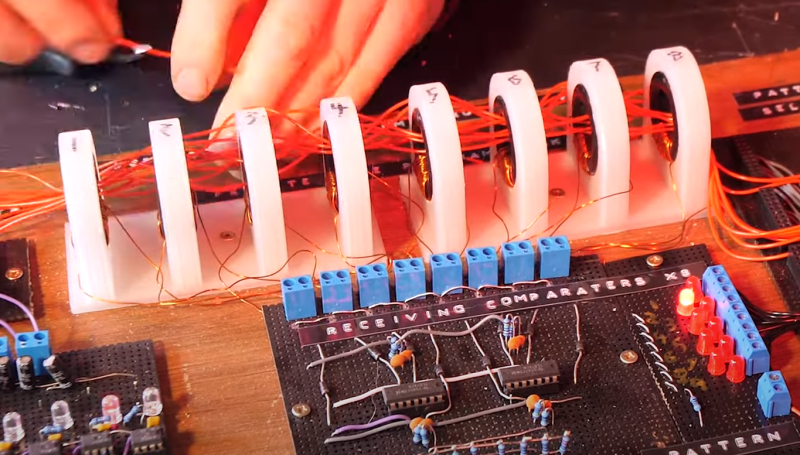One of our favorite musical hackers, [Look Mum No Computer] is getting dangerously close to building a computer. His quest was to create a unique drum machine, inspired by a Soviet auto-dialer that used rope core memory for number storage. Rope memory is the read-only sibling to magnetic core memory, the memory technology used to build some beloved computers back in the 60s and early 70s. Rope core isn’t programmed by magnetizing the ceramic donuts, but by weaving a wire through them. And when [Look Mum] saw the auto-dialer using the technology for a user-programmable interface, naturally, he just had to build a synth sequencer.
The basic technology is to monitor the ferrite ring using a primary winding connected to a comparator. Then run the signal wire through some of the rings, and use a 555 to send an oscillating signal through it. The individual bits, AKA ferrite rings, pick up the signal and trigger the comparator. (Using transformers as bits, what fun!) So for a working sequencer, each ferrite ring controls an instrument. Ring 1 is a kick drum, ring 2 is a snare, etc. Then each wire is a different step, and they get powered sequentially. Wire the bit outputs to your instruments, and then weave your beats. It’s already the most unique sequencer we’ve ever seen, but there’s more.
Since he used really big ferrite cores, there was plenty of room to take beat submissions from his community, so there’s eight different beats “programmed” into this sequencer. And to switch between them? Looks like [Look Mum] is using a step-by-step module from the old phone system. Dial-a-beat!

















I admire this guy’s energy.
I saw him play live, he’s just a constant ball of energy its fantastic!
If only he could teach that. ;)
A project with quite some effort and returns that actually make it worth it :)
And yes what mime said, the energy of this guy makes me feel elated as well!
You should also remember that any number of wires in the same direction will add up, while winding them in the other direction will subtract, so you can perform logic operations like XOR with core rope memory. It just needs to be synchronous, e.g. from the same oscillator without phase delay.
he should definitely light up the donut as they get read for extra look :)
yep hes a guru, his effort on Jean’s pipe organ is amazing keeping it going and putting it on display in his museum. The Junk Rock series are pretty great too for quirky creative kids (and older kids). he does well explaining the circuity, oh how I wish we had school science teachers like him back in the day!